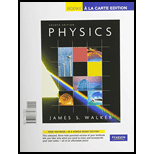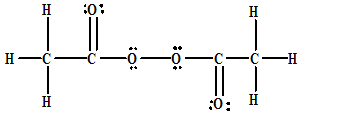
Student Solutions Manual For Masterton/hurley's Chemistry: Principles And Reactions, 8th
8th Edition
ISBN: 9781305095236
Author: Maria Cecilia D. De Mesa, Thomas D. Mcgrath
Publisher: Cengage Learning
expand_more
expand_more
format_list_bulleted
Concept explainers
Textbook Question
Chapter 7, Problem 40QAP
An objectionable component of smog is acetyl peroxide, which has the following skeleton structure.

(a) Draw the Lewis structure of this compound.
(b) Write the bond angles indicated by the numbered angles.
Expert Solution & Answer
Want to see the full answer?
Check out a sample textbook solution
Students have asked these similar questions
You are trying to decide if there is a single reagent you can add that will make the following synthesis possible without any other major side products:
xi
1. ☑
2. H₂O
хе
i
Draw the missing reagent X you think will make this synthesis work in the drawing area below.
If there is no reagent that will make your desired product in good yield or without complications, just check the box under the drawing area and leave it blank.
Click and drag to start drawing a
structure.
There is no reagent that will make this synthesis work without complications.
: ☐
S
☐
Predict the major products of this organic reaction:
H
OH
1. LiAlH4
2. H₂O
?
Note: be sure you use dash and wedge bonds when necessary, for example to distinguish between major products with different stereochemistry.
Click and drag to start drawing a
structure.
G
C
टे
For each reaction below, decide if the first stable organic product that forms in solution will create a new C-C bond, and check the appropriate box.
Next, for each reaction to which you answered "Yes" to in the table, draw this product in the drawing area below.
Note for advanced students: for this problem, don't worry if you think this product will continue to react under the current conditions - just focus on the first
stable product you expect to form in solution.
NH2
CI
MgCl
?
Will the first product that forms in this reaction
create a new CC bond?
Yes
No
MgBr
?
Will the first product that forms in this reaction
create a new CC bond?
Yes
No
G
टे
Chapter 7 Solutions
Student Solutions Manual For Masterton/hurley's Chemistry: Principles And Reactions, 8th
Ch. 7 - Prob. 1QAPCh. 7 - Prob. 2QAPCh. 7 - Follow the directions of Question 1 for (a) IO2-...Ch. 7 - Follow the directions of Question 1 for (a) CIF4-...Ch. 7 - Follow the directions of Question 1 for (a) OCl2...Ch. 7 - Follow the directions of Question 1 for (a) C22-...Ch. 7 - Oxalic acid, H2C2O4, is a poisonous compound found...Ch. 7 - Radio astronomers have detected the isoformyl ion,...Ch. 7 - Draw Lewis structures for the following species....Ch. 7 - Follow the directions of Question 9 for the...
Ch. 7 - Dinitrogen pentoxide, N2O5, when bubbled into...Ch. 7 - Formic acid is the irritating substance that gets...Ch. 7 - Two different molecules have the formula C2H2Cl2....Ch. 7 - Two different molecules have the formula C2H6O....Ch. 7 - Prob. 15QAPCh. 7 - Prob. 16QAPCh. 7 - Write a Lewis structure for (a) XeF3+ (b) PCl4+...Ch. 7 - Write a Lewis structure for (a) BCl4 (b) ClO- (c)...Ch. 7 - Write reasonable Lewis structures for the...Ch. 7 - Write reasonable Lewis structures for the...Ch. 7 - Prob. 21QAPCh. 7 - Draw resonance structures for (a) SeO3 (b) CS32-...Ch. 7 - Prob. 23QAPCh. 7 - Prob. 24QAPCh. 7 - The skeleton structure for disulfur dinitride,...Ch. 7 - Borazine, B3N3H6, has the skeleton Draw the...Ch. 7 - What is the formal charge on the indicated atom in...Ch. 7 - Prob. 28QAPCh. 7 - Below are two different Lewis structures for...Ch. 7 - Below are two different Lewis structures for the...Ch. 7 - Predict the geometry of the following species: (a)...Ch. 7 - Predict the geometry of the following species: (a)...Ch. 7 - Predict the geometry of the following species: (a)...Ch. 7 - Predict the geometry of the following species: (a)...Ch. 7 - Predict the geometry of the following species: (a)...Ch. 7 - Predict the geometry of the following species: (a)...Ch. 7 - Give all the ideal bond angles (109.5, 120, or...Ch. 7 - Prob. 38QAPCh. 7 - Prob. 39QAPCh. 7 - An objectionable component of smog is acetyl...Ch. 7 - The uracil molecule is one of the bases in DNA....Ch. 7 - Niacin is one of the B vitamins (B3). Estimate the...Ch. 7 - Which of the species with octets in Question 31...Ch. 7 - Which of the species with octets in Question 32...Ch. 7 - Which of the species with octets in Question 33...Ch. 7 - Prob. 46QAPCh. 7 - There are three compounds with the formula...Ch. 7 - There are two different molecules with the formula...Ch. 7 - Give the hybridization of the central atom in each...Ch. 7 - Give the hybridization of the central atom in each...Ch. 7 - Give the hybridization of the central atom in each...Ch. 7 - Give the hybridization of the central atom in each...Ch. 7 - Give the hybridization of the central atom in each...Ch. 7 - Give the hybridization of the central atom in each...Ch. 7 - In each of the following polyatomic ions, the...Ch. 7 - Follow the directions of Question 55 for the...Ch. 7 - Give the hybridization of each atom (except H) in...Ch. 7 - Acrylonitrile, C3H3N is the building mer Orlon....Ch. 7 - What is the hybridization of nitrogen inCh. 7 - What is the hybridization of carbon inCh. 7 - Give the hybridization of the central atom...Ch. 7 - Give the hybridization of the central atom...Ch. 7 - Give the number of sigma and pi bonds in the...Ch. 7 - Give the number of sigma and pi bonds in the...Ch. 7 - Give the number of sigma and pi bonds in each...Ch. 7 - Give the number of sigma and pi bonds in each...Ch. 7 - In which of the following molecules does the...Ch. 7 - Consider the pyrosulfate ion, S2O72-. It has no...Ch. 7 - Consider acetyl salicylic acid, better known as...Ch. 7 - Complete the table on next page.Ch. 7 - Given the following electro negativities...Ch. 7 - Based on the concept of formal charge, what is the...Ch. 7 - Describe the geometry of the species in which...Ch. 7 - Consider the following molecules: SiH4, PH3, H2S....Ch. 7 - Prob. 75QAPCh. 7 - In each of the following molecules, a central atom...Ch. 7 - Prob. 77QAPCh. 7 - A compound of chlorine and fluorine, CIFx, reacts...Ch. 7 - Draw the Lewis structure and describe the geometry...Ch. 7 - Consider the polyatomic ion IO65-. How many pairs...Ch. 7 - It is possible to write a simple Lewis structure...Ch. 7 - Phosphoryl chloride, POCl3, has the skeleton...
Knowledge Booster
Learn more about
Need a deep-dive on the concept behind this application? Look no further. Learn more about this topic, chemistry and related others by exploring similar questions and additional content below.Similar questions
- For each reaction below, decide if the first stable organic product that forms in solution will create a new CC bond, and check the appropriate box. Next, for each reaction to which you answered "Yes" to in the table, draw this product in the drawing area below. Note for advanced students: for this problem, don't worry if you think this product will continue to react under the current conditions - just focus on the first stable product you expect to form in solution. དྲ。 ✗MgBr ? O CI Will the first product that forms in this reaction create a new C-C bond? Yes No • ? Will the first product that forms in this reaction create a new CC bond? Yes No × : ☐ Xarrow_forwardPredict the major products of this organic reaction: OH NaBH4 H ? CH3OH Note: be sure you use dash and wedge bonds when necessary, for example to distinguish between major products with different stereochemistry. Click and drag to start drawing a structure. ☐ : Sarrow_forwardPredict the major products of this organic reaction: 1. LIAIHA 2. H₂O ? Note: be sure you use dash and wedge bonds when necessary, for example to distinguish between major products with different stereochemistry. Click and drag to start drawing a structure. X : ☐arrow_forward
- For each reaction below, decide if the first stable organic product that forms in solution will create a new C - C bond, and check the appropriate box. Next, for each reaction to which you answered "Yes" to in the table, draw this product in the drawing area below. Note for advanced students: for this problem, don't worry if you think this product will continue to react under the current conditions - just focus on the first stable product you expect to form in solution. NH2 tu ? ? OH Will the first product that forms in this reaction create a new CC bond? Yes No Will the first product that forms in this reaction create a new CC bond? Yes No C $ ©arrow_forwardAs the lead product manager at OrganometALEKS Industries, you are trying to decide if the following reaction will make a molecule with a new C-C bond as its major product: 1. MgCl ? 2. H₂O* If this reaction will work, draw the major organic product or products you would expect in the drawing area below. If there's more than one major product, you can draw them in any arrangement you like. Be sure you use wedge and dash bonds if necessary, for example to distinguish between major products with different stereochemistry. If the major products of this reaction won't have a new CC bond, just check the box under the drawing area and leave it blank. Click and drag to start drawing a structure. This reaction will not make a product with a new CC bond. G marrow_forwardIncluding activity coefficients, find [Hg22+] in saturated Hg2Br2 in 0.00100 M NH4 Ksp Hg2Br2 = 5.6×10-23.arrow_forward
- give example for the following(by equation) a. Converting a water insoluble compound to a soluble one. b. Diazotization reaction form diazonium salt c. coupling reaction of a diazonium salt d. indacator properties of MO e. Diazotization ( diazonium salt of bromobenzene)arrow_forward2-Propanone and ethyllithium are mixed and subsequently acid hydrolyzed. Draw and name the structures of the products.arrow_forward(Methanesulfinyl)methane is reacted with NaH, and then with acetophenone. Draw and name the structures of the products.arrow_forward
- 3-Oxo-butanenitrile and (E)-2-butenal are mixed with sodium ethoxide in ethanol. Draw and name the structures of the products.arrow_forwardWhat is the reason of the following(use equations if possible) a.) In MO preperation through diazotization: Addition of sodium nitrite in acidfied solution in order to form diazonium salt b.) in MO experiment: addition of sodium hydroxide solution in the last step to isolate the product MO. What is the color of MO at low pH c.) In MO experiment: addition of sodium hydroxide solution in the last step to isolate the product MO. What is the color of MO at pH 4.5 d.) Avoiding not cooling down the reaction mixture when preparing the diazonium salt e.) Cbvcarrow_forwardA 0.552-g sample of an unknown acid was dissolved in water to a total volume of 20.0 mL. This sample was titrated with 0.1103 M KOH. The equivalence point occurred at 29.42 mL base added. The pH of the solution at 10.0 mL base added was 3.72. Determine the molar mass of the acid. Determine the Ka of the acid.arrow_forward
arrow_back_ios
SEE MORE QUESTIONS
arrow_forward_ios
Recommended textbooks for you
 Chemistry: The Molecular ScienceChemistryISBN:9781285199047Author:John W. Moore, Conrad L. StanitskiPublisher:Cengage Learning
Chemistry: The Molecular ScienceChemistryISBN:9781285199047Author:John W. Moore, Conrad L. StanitskiPublisher:Cengage Learning

Chemistry: The Molecular Science
Chemistry
ISBN:9781285199047
Author:John W. Moore, Conrad L. Stanitski
Publisher:Cengage Learning
INTRODUCTION TO MOLECULAR QUANTUM MECHANICS -Valence bond theory - 1; Author: AGK Chemistry;https://www.youtube.com/watch?v=U8kPBPqDIwM;License: Standard YouTube License, CC-BY